In 2012, Philips debuted its Hue wireless lighting control system. Operated through a smartphone- or tablet-based application, Hue can be customized to provide the ideal lighting for any situation, time of day or purpose, in addition to its numerous other functions. Recently, the company announced an update to the technology behind the app that will allow for greater customization.
This latest update builds on the upgrades to Hue released in March – namely, the software development kit. According to Apple Insider, this allows developers of mobile software to integrate Hue's functionality into their latest apps. The source cites Ambify as an example of this – a program that uses data from music playing on an Apple iOS device and changes the color of Hue bulbs as a result.
Those with an interest in planning a lighting setup around a Hue system will want to familiarize themselves with the basics of Hue's bulbs and app as well as the recent upgrades.
Hue – a primer
Hue operates through three components – energy-efficient LED bulbs designed to recreate every natural-spectrum color including all shades of white light, a "bridge" that connects to a wireless internet router and an app available for iOS- or Android-powered smartphones and tablets. Over 50 bulbs can be linked and controlled through the system once it is set up.
The customization capabilities of Hue – even in its original form – are considerable. Users can set bulbs to gradually brighten in the morning and dim at night, or use photos stored on a device as the basis for the color of the light in a room.
Features of the updated app
Apple Insider reports that in its latest iteration, Hue can use geofencing technology to track a user's location and act accordingly – for example, turning on when a person is steps away from their house. Even more remarkably, it can extract data from a user's mobile device and use the bulbs to project emails, stock prices, weather and other practical information as "visual cues."





